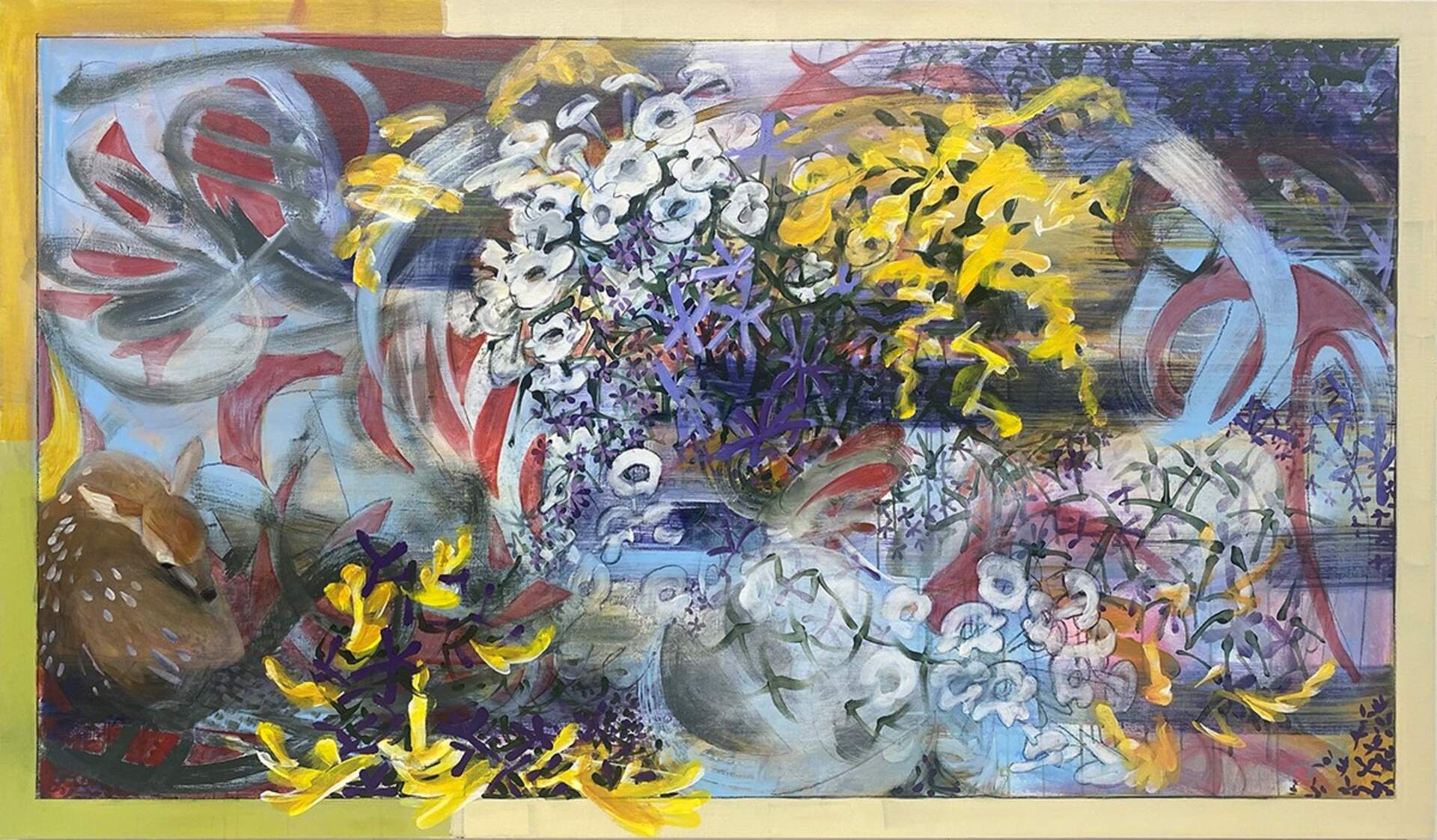Mike Glier (b. 1953)Fawn Exhaling
2022
acrylic on canvas
48 x 82 inches
Courtesy Krakow Witkin Gallery, Boston
SOUND AND THE UMWELT
MG: Every time I see Song of the Tree Cricket, I think about tapestry, so woven is the little cricket into its dense summer bower. Burchfield uses three motifs, arrows, circles and half circles, which emanate from the cricket as a sound. The same motifs extend into the trunk, leaves, stars and moons of its surroundings. The embeddedness of the cricket makes me think that this picture is from the insect’s point of view. The cricket seems to have no sense of place or self, but perceives place and self as a continuous thing, unlike human perception, which is always parsing things.
NW: How interesting that Song of the Tree Cricket makes you think of tapestry. I feel it beautifully illustrates Burchfield’s long-standing fascination with the sounds and patterns of nature, made visible through his sound-sight synesthesia. On a late summer’s night, you hear the tree cricket chorus, but you don’t see the tiny insects themselves—they are indeed woven invisibly into tree canopies. I’ve only ever seen one during daylight hours. The diminutive snowy tree cricket is only 1/2 to 5/8 inches long, has a pale green body, and a pair of red spots mark where antennae attach to its head. The males’ continuous trilling sounds attract females for mating. (In 1897, Amos E. Dolbear came up with a formula for “The Cricket as a Thermometer.” In this geographic area, the temperature in Fahrenheit can be estimated by counting the chirps in 13 seconds and adding 40. Charles and Bertha Burchfield tested “Dolbear’s Law” many times and found it to be remarkably accurate.) But I digress.
MG: More digressions like this, please!
NW: Every year Burchfield would visit his backyard willow tree to hear the “Tree-cricket chorus in full song.” For his painting, he conveyed the loud, rhythmic sounds that dominated his experience. A vertical column of chevrons emerges from a horned black and red shape punctuated by a pair of tiny white dots. The audio-cryptogram expands into a split “M” which resembles his 1917 Convention for Abstract Thoughts for “Morbid brooding.” It radiates sideways in semi-circular forms echoed in tiny down-turned crescents. In later years, he attributed this shape to mean “astonishment, wariness, foreboding, sadness, nostalgia”—the emotions we share as we realize summer is coming to an end. The planet Jupiter and sparkling stars peek through upper willow branches, providing drastic contrasts between the artist’s notion of infinity and the yearning song of a tiny insect. This painting is the tree cricket’s Umwelt—its wild, instinctive acoustic world embedded within its reproductive cycle critical for survival.
MG: On our farm a parcel of once cultivated land has been left to grow wild for 50 years. Unimaginatively, we call it the “Wild Spot” and one day walking within it, I saw a fawn curled up in a little clearing under tall bushes, surrounded by undergrowth and I got to wondering what she saw and smelled and heard and how she processed all this. I try to give animals agency when I put them into pictures so that they are more than an object of human curiosity and entertainment. Accordingly, I chose a title that is about the fawn doing something, “exhaling”, so we start to think about her experience rather than ours. In this picture I hope one might have a moment of empathy and get a sense of being under the bushes, avoiding danger by hiding in the goldenrod, and using the sense of smell to learn about what lies beyond.
NW: You captured this so well. I love how the camouflaged fawn’s warm exhalation filled with scents and moisture, swirls around her and enters our space.
